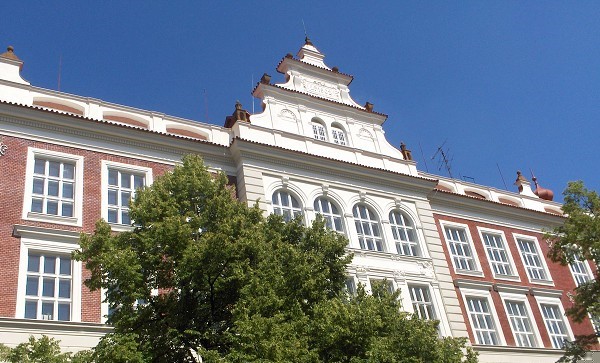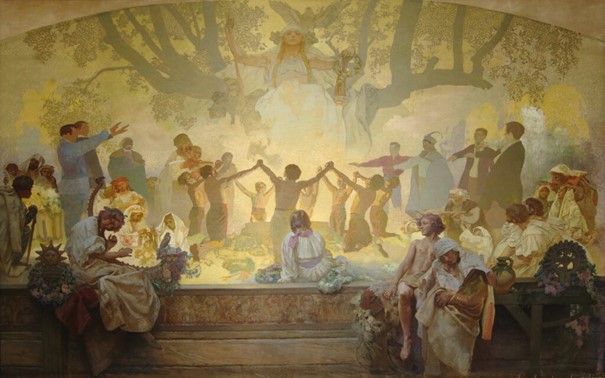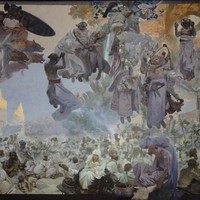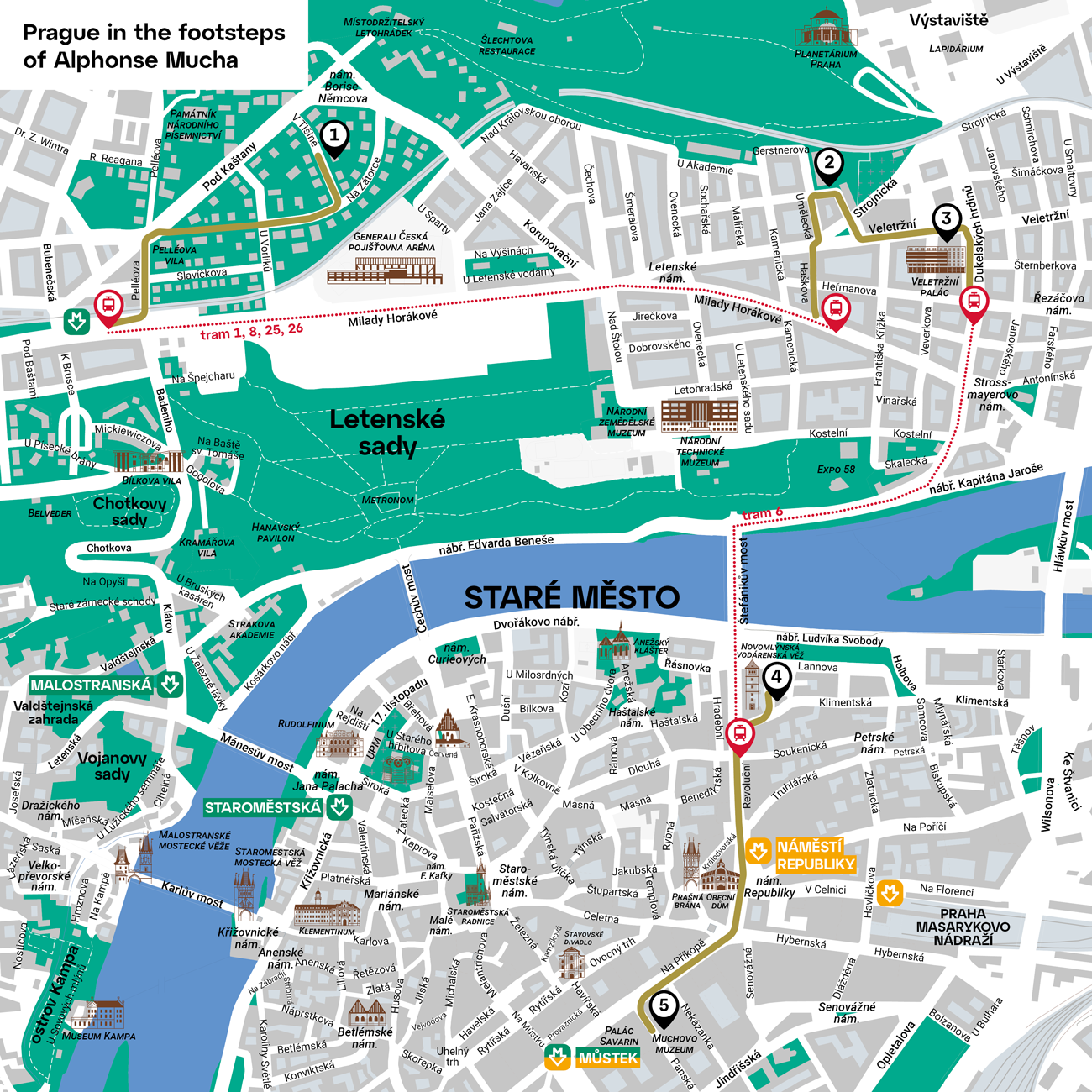Breadcrumbs navigation
IV. Prague in the footsteps of Alphonse Mucha
This route is partly on foot and partly by tram: Mucha’s villa – U Studánky school – Trade Fair Palace – Postal Museum – Mucha Museum
Mucha’s villa
Your walk begins in Bubeneč at Mucha’s villa, which is located at V Tišině 4. The architectural design of the villa in the Neoclassicist style was commissioned by Alphonse Mucha from the architect Bohumil Hybšman, and its realization took place between 1925 and 1928. This has two upper floors, where the ground floor and first floor served as living space, with Mucha’s studio on the second floor. Shortly after the Nazi occupation and the death of Alphonse Mucha, a Wehrmacht officer moved into the villa, who greatly contributed to the fact that Alphonse Mucha’s widow Marie Muchová was allowed to stay in the house, as well as preserving the collection of Mucha’s works. After the end of the war, Mucha’s son Jiří and his family moved here. In 1950 however, the villa was nationalized and its residents forcibly evicted. After 1990, it was returned to the family, rented to the Embassy of Ghana and sold to financier Pavel Hubáček by Jarmila Mucha Plockova in 2015. At present the villa is undergoing complete reconstruction.
U Studánky elementary school and kindergarten
After a short tram ride from Hradčanská to the Kamenická stop, you will get to see a number of buildings that are inherently connected with the life and work of Alphonse Mucha. Today’s U Studánky elementary school and kindergarten of the Charles University Faculty of Education at Umělecká 8 was built on the site of a former well that used to supply the nearby 'Meierhof' manor of the ecclesiastical administrator; hence the poetic name, which means ‘by the wellspring’. Construction took place between 1901 and 1902 in the neo-Renaissance style to the design of city engineer J. Zlatník. The elementary and secondary schools were divided into a girls’ (northern) and boys’ (southern) sections.

The interior of the former school chapel served to store the Slav Epic canvasses from 1926 on. ‘For the provisional storage of the ‘Epic of all the Slavs’ paintings by Master Mucha, the former exhortation hall on the second floor of the “U Studánky” school in Prague VII has been designated’, (source: Mucha Foundation, cit. City Council, 15th meeting, 16 April 1926, IN: Bulletin of the City of Prague. 19 April 1926). ‘... now I have a studio here, as negotiated from the municipality, which I’m presently arranging. There I will work on finishing and completing each tableau in turn. It behoves for all 20 canvasses to fit in there and be so placed that I could reach each one. This will be devised by hanging them on girders, with pulleys and shunting.’ (source: Mucha Foundation, cit. Alphonse Mucha, Prague letter to his brother-in-law Jan Remund, Rosice, 13 May 1926). It was at the U Studánky school that Mucha also completed this magnificent work in 1928.
The Trade Fair Palace
Moving on from the school, this time we’ll walk along Umělecká street to Veletržní and then go on to the impressive building of The Trade Fair Palace. It was in its time the largest building of its kind in the world, and Prague’s first building in a new style – Functionalism. During the First Republic, this palazzo was used primarily to serve the needs of trade-fair exhibitions.
For Alphonse Mucha, however, the Trade Fair Palace acquired a different and profound meaning: the completed cycle of the Slav Epic i.e. all 20 canvasses, was presented to the Prague public for the first time there, in the Great Hall; this happened in the autumn of 1928 on the occasion of the celebration of ten years of independence of the Czechoslovak republic. The Slav Epic exhibit was treated with great regard, the Great Hall was transformed into an autumn orchard, where paths sprinkled with sand led around the paintings.

During the Nazi occupation, the Trade Fair Palace became sadly infamous as the massing-point for Jews sent to the concentration camps, later serving as an administrative building and suffering a major fire in 1974. Since 1995 it has been the Prague seat of the National Gallery, whose collections include Mucha’s portrait of Josephina Crane Bradley as Slavia, his oil painting ‘The Czech Heart’ and a number of Mucha’s poster designs.
The Postal Museum
To get there you can take Tram No. 6 to the stop at Dlouhá třída – our destination is the Postal Museum. Alphonse Mucha became widely known not only for Sarah Bernhardt posters or the Slav Epic, but also as the author of the first Czechoslovak postage stamps.  These can be seen in the Postal Museum, which was established shortly after the founding of Czechoslovakia, on 18 December 1918. Postal history memorabilia were meant to illustrate the special standing of the Czech and Slovak nation. At the same time, on the same day, the first Czechoslovak stamp was issued, to a design by Alphonse Mucha representing the Hradčany castle skyline. The newly established postal administration asked for a design on October 30, saying that in order to mass-reproduce the monetary‑value stamp, which was of utmost importance to the state, the design had to be ready within 24 hours. ‘One day, after visiting Prague, he did not go to his large workshop, but sat down at the window in the library where he sketched some compositions, and on one of them I saw the outline of Hradčany in the background. When I asked what he was doing, he told me: ‘These are the new stamps for the Matice organisation and I have to hurry with them, they will be printed at the Union printworks right away.’ I noticed that he was joyful and excited, but I didn’t inquire further.
These can be seen in the Postal Museum, which was established shortly after the founding of Czechoslovakia, on 18 December 1918. Postal history memorabilia were meant to illustrate the special standing of the Czech and Slovak nation. At the same time, on the same day, the first Czechoslovak stamp was issued, to a design by Alphonse Mucha representing the Hradčany castle skyline. The newly established postal administration asked for a design on October 30, saying that in order to mass-reproduce the monetary‑value stamp, which was of utmost importance to the state, the design had to be ready within 24 hours. ‘One day, after visiting Prague, he did not go to his large workshop, but sat down at the window in the library where he sketched some compositions, and on one of them I saw the outline of Hradčany in the background. When I asked what he was doing, he told me: ‘These are the new stamps for the Matice organisation and I have to hurry with them, they will be printed at the Union printworks right away.’ I noticed that he was joyful and excited, but I didn’t inquire further.
I was not surprised, because he was so often engaged in drawing stickers and posters for our national associations. It was only when the first print proofs arrived that I learned that these were to be our first Czechoslovak stamps, as yet drawn right under the protective wings of the Austrian eagle poised over the imperial post offices, only to be replaced in short order by our Czech lion.’ (source Mucha Foundation).
The Mucha Museum – saving the best till last!
A longer walk along Revoluční and Na Příkopě streets will take you to Panská street 7, where the Mucha Museum is located.

The museum presents the artist’s complete works in seven thematically arranged units. In the first part, called the decorative panneau, you can see how Mucha’s style developed. In the second part, you will get acquainted with the posters he created in Paris in the 1890s, for Sarah Bernhardt, among others. The third part deals with Mucha’s decorative designs for jewellery, furniture and other objects of applied art. The fourth section presents his posters for Czech associations, such as Sokol, and others. The fifth section presents Alphonse Mucha as a painter. Here you can see primarily his oil paintings, which culminated in the famous Slav Epic. The sixth part shows his drawings and pastels, and the final seventh part presents the artist’s life in photographs and personal items.
Route map
1. Mucha’s villa (V Tišině 4)
2. U Studánky school (Umělecká 8)
3. Trade Fair Palace (Dukelských hrdinů 47)
4. Postal Museum (Nové mlýny 2)
5. Mucha Museum (Panská 7)
TIP: Head to the Waldstein Riding School and visit the exhibition "Mucha: The Family Collection", presenting the artist's works in a way he has never been presented before.



